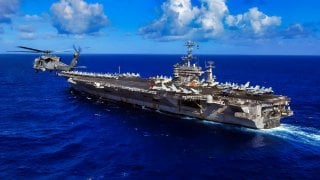1 Nimitz-Class Navy Aircraft Carrier 'Will Go Nowhere' for over 5 Years
The USS John C. Stennis (CVN-74) is undergoing a delayed Refueling and Complex Overhaul (RCOH), now expected to be completed by October 2026, 14 months later than initially planned. The project started in 2021.
What You Need to Know: The USS John C. Stennis (CVN-74), undergoing its Refueling and Complex Overhaul (RCOH), will not return to service on schedule. Originally set for completion by August 2025, delays have pushed the expected finish to October 2026.

-The pandemic and staffing shortages have contributed to the extended timeline, mirroring the lengthy overhaul of the USS George Washington.
-In addition to significant technological upgrades, the carrier may also be renamed, as its current namesake, Senator John C. Stennis, is controversial for his opposition to civil rights legislation. A new name may be in line with efforts to reflect contemporary values.
USS John C. Stennis Delayed Until 2026: Could a Name Change Be Next?
The U.S. Navy's Nimitz-class nuclear-powered supercarrier USS John C. Stennis (CVN-74) will not return to service on schedule.
The sea service announced earlier this year that the carrier's midlife overhaul and refueling will take about five and a half years, which is some 14 months longer than first expected. The warship began its Refueling and Complex Overhaul (RCOH) in 2021, and work was originally set to be finished by August 2025. The updated timeline calls for the flattop to be returned to the U.S. Navy no earlier than October 2026.
CVN-74’s is the second RCOH in recent years to cause hardship for a ship’s crew. USS George Washington’s midlife upgrade took nearly six years. Eleven sailors took their own lives during the time the ship was stuck at the HII Newport News Shipbuilding facilities.
Stennis: Delayed Midlife Overhaul and Possible Name Change
In April, CVN-74 exited dry dock and began the second phase of its RCOH, with work reportedly more than 65% completed. The ship has since been moved to an outfitting berth as shipyard workers and the crew install and test the warship's major components and other systems.
The Navy says several post-pandemic challenges continue to impact the U.S. carrier industrial base. Capabilities and capacities are reduced as the shipyards struggle to find adequate staff to build and maintain warships.
The Navy insists the delays won't impact the capabilities of the warship and will be worth the added time.
"When John C. Stennis redelivers, she'll be the most technologically advanced Nimitz-class aircraft carrier in the Navy," said Rear Adm. Casey J. Moton in April. "She'll bring to the Fleet the highest level of capability across all mission sets."

According to the Navy, more than 25 million total man-hours of work will go into the RCOH, nearly as much time as was spent building the carrier.
"RCOH construction enhances nearly every space and system on the carrier, beyond the most critical requirement to defuel and refuel the ship's two nuclear reactors and to repair and upgrade the propulsion plant," said Capt. Mike Johnson, manager of the PEO Aircraft Carriers In-Service Aircraft Carrier Program Office. "We work on every part of the ship, from the hull, screws, and rudders to more than 600 tanks; thousands of valves, pumps, and piping components; electrical cables and ventilation; as well as combat and aviation support systems. It's demanding, complex work that challenges every member of the planning team, shipyard crews, and ship's force."
Still the Stennis? Maybe Not
CVN-74 will not be quite the same ship. Upgrades will make the vessel practically as good as new, and perhaps even a better ship than when she entered service in 1995.
In addition to the technological improvements, it is possible the warship could sail with a new name.
The seventh Nimitz-class supercarrier was named for Democratic Sen. John C. Stennis of Mississippi. The lawmaker, who hadn't lost an election in 60 years, was seen as an odd choice to receive the honor, but the name still gained the approval of President Ronald Reagan in 1988.
The lead ship of the class of U.S. Navy supercarriers was fittingly named for World War II Fleet Admiral Chester W. Nimitz, and subsequent carriers of the class were named for past presidents. Though USS Carl Vinson (CVN-70) honored a congressman, he was known as the father of the two-ocean Navy, and the name was considered fitting.
By contrast, Stennis had little to do with naval affairs.
Moreover, the naming of the carrier has been the subject of controversy as Stennis was an outspoken critic of civil rights and racial equality, while the ship's nickname – "Johnny Reb" – has drawn its share of criticism in recent years.
The U.S. military has gone to great (and at times expensive) lengths to retire the names of bases and other warships that seemed to honor Confederate military leaders. While Stennis was a U.S. lawmaker, his policies seem at odds with the direction the country has taken. He voted against or actively opposed the Civil Rights Act of 1964, the Civil Rights Act of 1968, and the establishment of Martin Luther King Jr. Day as a federal holiday.
It is likely that by the time CVN-74 sails again, it will be named for someone other than John C. Stennis.
Author Experience and Expertise: Peter Suciu
Peter Suciu is a Michigan-based writer. He has contributed to more than four dozen magazines, newspapers, and websites with over 3,200 published pieces over a twenty-year career in journalism. He regularly writes about military hardware, firearms history, cybersecurity, politics, and international affairs. Peter is also a Contributing Writer for Forbes and Clearance Jobs. You can follow him on Twitter: @PeterSuciu. You can email the author: [email protected].
Image Credit: Creative Commons.


